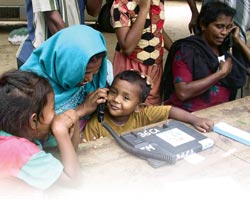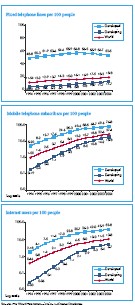|
ITU-led global development community strives to Connect
the World
In June 2005, ITU launched an important new development initiative designed
to bring access to information and communication technologies (ICT) to the estimated one billion people worldwide for whom making a simple
telephone call remains far out of reach.
 |
|
Representatives of the founding
partners in the Connect the World initiative, at its launch in Geneva by
ITU on 16 June 2005
ITU 055072/Jean-Marc Ferré |
Known as Connect the World, the initiative creates a new development community
comprising 22 founding partners from the public and private sectors,
international organizations and civil society.
Initial partners include the governments of Egypt, France and Senegal, as well
as the Korea Agency for Digital Opportunity and Promotion, and leading
private-sector firms Alcatel, Huawei, Infosys, Intel, Microsoft, KDDI,
Telefónica and WorldSpace. International and regional organizations are also
partners, such as UN agencies UNESCO, the UN Fund for International Partnership
(UNFIP), the UN Development Programme (UNDP), and the Universal Postal Union (UPU),
as well as the International Telecommunications Satellite Organization (ITSO),
the European Commission and the Regional African Satellite Communications
Organisation (RASCOM). In addition, innovative players from civil society are
partners: Child Helpline International, the MS Swaminathan Research Foundation (MSSRF)
and Télécoms Sans Frontières.
Established within the context of the World Summit on the Information Society (WSIS)
Plan of Action, this new multi-stakeholder community is designed to harness the
existing expertise of organizations already working in the field, in an effort
to accelerate work to bridge the digital divide.
Launching the initiative alongside a host of partner representatives at the
Palais des Nations on 16 June 2005, ITU Secretary-General Yoshio Utsumi said the
effectiveness of strategies to bring the benefits of ICT to the world’s
estimated 800 000 unconnected villages would ultimately rest on the ability to
learn from and capitalize on past experience. “It’s not ICT that will solve the
problem of the digital divide, it’s people — and especially people working in
partnership,” he said. “While Connect the World is about harnessing the power of
ICT, it’s also about harnessing the power of people working together to connect
the unconnected.”
A holistic approach
 |
| Télécoms Sans Frontières |
The Connect the World concept comprises three key building blocks — “Enabling
Environment,” “Infrastructure and Readiness,” and “Applications and Services” —
which together constitute the primary areas ITU believes need to be addressed in
developing effective measures to stimulate ICT development.
To qualify for Connect the World membership, all partners must have current
development projects in one or more of these areas. For its own part, ITU has
nominated three principal projects — one for each key building block — which it
will promote through the Connect the World framework.
For Building Block 1, “Enabling Environment,” ITU is leading a project to
improve the measurement of ICT indicators at local, national and regional
levels. Working with partners including UNESCO, OECD and the World Bank , the
project aims to develop a core set of internationally agreed ICT indicators.
These will help national statistical offices build effective and accurate ICT
data compilation programmes on the information society, as well as serving as
the platform for an online global ICT database.
ITU’s project for Building Block 2, “Infrastructure and Readiness,” is its
network of Centres of Excellence, which are now delivering sustainable,
capacity-building training programmes for telecommunication decision-makers and
executives worldwide. In addition to providing courses on various aspects of
advanced ICT, telecommunication financing and multilateral trade, the centres
also provide resources for the development and harmonization of
telecommunication standards across regions, serve as a focal point for a wide
range of information society initiatives, and offer consultancy services to
governments and the private sector.
For Building Block 3, “Applications and Services,” ITU is leading the Internet
for Schools initiative in Mali, which aims to provide 14–20 year-olds living in
remote rural communities with a valuable new educational tool. Project partners
Swisscom, Engacom and Mali’s Ministry of Communications and New Technologies are
working with ITU to provide expertise, equipment, financial support and the
necessary infrastructure to set up sustainable school computer laboratories in
isolated communities, including Timbuktu, Sevaré and Mopti.
By leading the way with projects to connect the unconnected, and by providing an
international platform to showcase the many successful development initiatives
being undertaken by other entities worldwide, ITU hopes Connect the World will
spur organizations at every level to get more actively involved in ICT
development.
“Every Connect the World partner is working to make a real difference. ITU’s
hope is that the projects they are showcasing within this initiative will serve
to stimulate new partnerships and inspire others to join us and launch their own
development activities,” said Secretary-General Utsumi.
|
ICT indicators
ITU estimates show that some 800 000 villages — representing around 30
per cent of all villages worldwide — are still without connection to any
kind of ICT. Even in areas where basic services are available, ITU
figures show that the 942 million people living in the world’s developed
economies enjoy four times better access to fixed and mobile phone
services, eight times better access to Internet services, and own 13
times more PCs than the 85 per cent of the world’s population living in
developing countries (see charts).
Fixed telephone line access
Progress is evident in this chart, which shows growing access to fixed
telephone lines over the past decade or so. The gap has been reduced,
but it still remains substantial.
Mobile subscribers
The gap in mobile access has been reduced even more. Despite this
progress though, in the rich countries of the world, users still enjoy
at least four times better access to both fixed and mobile phone
services.
Internet access
The gap is larger for access to the Internet and personal computers.
Internet usage is eight times higher in the developed world than in the
developing world, even though this has fallen from a gap of over 72
times.
|
Click on the graphic to enlarge it |
|
 |
|



